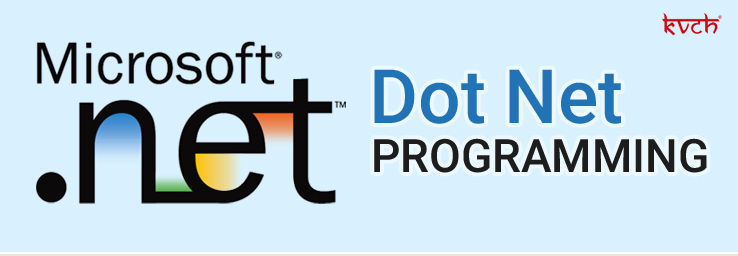Live Project Based .NET training in Noida
 4.8 out of 5
based on 5975 ratings.
4.8 out of 5
based on 5975 ratings.
KVCH is the pioneer of education and also the Best .NET training institute in Noida Delhi and Bhopal. We provide our candidates with latest curriculum on the technology that helps them to secure best jobs in the industry . The training program is designed for both students and working professionals who are looking for a career in this field .
The .NET training in Noida , Delhi and Bhopal , comprises of both practical and theoretical sessions consisting of modules like ASP .Net , WCM , WPF , C# , MVC , Silver light , etc. Students are regularly encouraged to focus and grab the technology conceptually. And that makes the student of KVCH different from others in the industry as they are become highly efficient in the technology they opt.
With experience of more than 25 years , we have delivered thousands of well qualified students to the IT industry . We conduct various campus drives for all the KVCH students . Our specialized placement cell provide assistance and guidance to the aspirants looking for jobs.
At KVCH , we have well qualified experienced trainers who have years of experience in dealing with the LIVE Projects . Students are introduced to both basic and professional level projects based where they learn various aspect of .NET like its concepts and fundamentals.
We help aspirants to gain required skills and knowledge and aid them with the best placement programs.
Benefits

Accredited Curriculum

Learn from the Experts

Professional Certificate

Guranteed Career Growth

Placement Assistance

Earn a Valuable Certificate
Course Description
Training in .NET is a modular 6 months course. The course curriculum of Training in .NET comprises of
- .NET Framework
- OverView
- CLR,CLS
- MSIL
- Assemblies
- NameSpaces
- .NET Languages
- Dll’s(Vs)Exe’s
Basics:
- Getting Started
- Using Variables and Arrays
- Methods and Parameters
- Decision Structures and Loops
- Handling Errors and Exceptions
OBJECT ORIENTED PROGRAMMING
- Classes, structures and enums
- Constructors
- Destructors
- Properties
- Inheritance
- -Shadowing(new methods)
- -Overriding
- Method Overloading
- this and base Keyword
- Sealed classes
- Interfaces, Abstract Classes
- Working with Delegates
- Designing and Implementing Events
- Generics
- Sealed classes and Partial classes
- C#.NET Application Architecture
- Solution, Projects
- Compiling, Debugging and Running in IDE
- System.Windows.Forms Assembly
- System.Drawing
- The Form Class
- Win Forms
- Visual Inheritance
- Programming with Controls
- User Controls
- System.IO
- Readers and Writers
- Streams
- System.Collections
- Hashtable
- ArrayList
- Formatters
- Binary Serialization
- Formatters, Binary Formatter
- SOAP Serialization
- XML Serialization
- Introduction
- Architecture
- System.Data.Dll
- System.Data.Oledb
- System.Data.SqlClient
- Data Readers
- Command Object
- Procedure Execution (PL/SQL)
- Data Tables
- Data Relations
- Data Views
- Strong Names
- GAC
- Private and Shared Assemblies
- SFA
- MFA
- Threading Introduction
- System.Thrading NameSpaces
- Thread Members
- Thread States
- Language Extensions
- Implicitly typed variables
- Extension methods
- Object initialization syntax
- Anonymous types
- Lambda expressions
- LINQ expressions
- Using via extension methods
- Filtering
- Sorting
- Aggregation
- Skip and Take operators
- Joins
- Deferred Execution
- Benefits and drawbacks
- IEnumerable vs IQueryable
- Using across tiers
- Data Projection
- Single result value
- Existing types
- Anonymous types
- Grouping
- New XML classes
- Generating XML
- Querying XML
- Using data projection
- Combining with XPath
- Attributes and mapping
- Creating a DataContext
- Deferred loading
- Saving changes
- Inserts and deletes
- Transactions
- Concurrency
- Handling exceptions
- ADO.NET Entity Framework
- Differences from LINQ to SQL
- Available providers
- Defining an Entity Data Model (EDM)
- Database-first vs. Model-first
- Object Services
- Change tracking
- Using EntityClient
- Using stored procedures
- Plain-Old CLR Object support (POCO) [.NET 4.0 only]
- N-tier and service-based applications
- Introducing WPF
- Understand the motivation behind WPF
- Examine the various 'flavors' of WPF applications
- Overview the services provided by WPF
- Examine the core WPF assemblies and namespaces
- Work with the Window and Application class types
- Learn the syntax of XAML
- Understand the XAML / code relationship
- Survey the core WPF control types
- Review the WPF control programming model
- Learn to position controls using layout managers
- Understand the role of WPF control commands
- WPF Document Controls
- Understand the scope of the WPF documents API
- Distinguish between fixed documents and flow documents
- Populate a document with inline and block elements
- Work with the WPF document APIs
- Understand the scope of WPFs graphical rendering services
- Work with the Shape types
- Work with Brushes and Pens
- Apply graphical transformations
- Understand the role of geometries and drawings
- Work with the visual programming layer
- Learn to manage binary resources
- Understand the role of logical resources
- Work with resources in XAML and procedural code
- Work with resource dictionaries
- Understand the resource lookup mechanism
- Know the role of dynamic resources
- Learn how to make use of system resources
- Learn how to define and apply WPF styles
- Learn to limit where a style can be applied
- Build new styles based on existing styles
- Understand the use of triggers
- Understand the scope of WPF's animation services
- Define animations in code and XAML
- Work with linear interpolation animations
- Work with key-frame-based animations
- Work with path-based animations
- WPF Data Binding
- Understand the WPF data binding mechanism
- Bind to custom objects
- WPF Templates and User Controls
- Understand the relationship between WPF logical and visual trees
- Learn to build custom control templates
- Examine options for building custom controls PROJECT WORK • Will be covered in c#.net/ASP.Net with MVC • All new technologies will be addressed by the faculty during teaching regular content ensuring complete awareness for the next future • Any other topics on request will be taught by our experienced faculty
- Basics
- Web Programming
- HTML, DHTML
- JavaScript
- IIS
- ASP
- Difference Between ASP and ASP.NET
- Architecture
- Inline Technique & Code-Behind Technique
- Code Render Blocks
- Server Controls
- Page Basics, Page lifecycle
- Post back Request
- View State, Directives
- Html Server Controls
- Web Server Controls
- Basic Web Controls
- List Controls, Data Controls
- Adv Controls, User Controls
- CUSTOM CONTROL Development
- THEMES AND SKINS
- MASTERPAGES AND SITE NAVIGATION
- Architecture
- DataReaders and DataSets
- Command Object
- Transaction Programming
- Procedure Execution
- Data Adapter and Data Set
- Data Tables
- Data Relation
- Data Views
- Updating Dataset
- Working with Data Controls
- GridView
- -Inserting, Updating, Deleting
- -Sorting in Data Grid
- -Paging in Data Grid
- DataSource Controls
- Dataset
- DetailsView
- FormView
- Data List
- Repeater Control
- Crystal Reports
- DTDs & XSDs
- Parsers
- SAX Model
- DOM Model
- XML Programming in .Net
- XML Readers
- XML Serialization
- Context
- View State
- Cookie State
- Session State
- Session Tracking
- Application Object
- Session and Application Events
- Machine.Config & Web.Config.
- App Setting
- Compilation Settings
- Custom Error Settings
- Session State Settings
- InProcess & OutProcess Sesstion States
- State Server & SQL Server
- Cookieless Session State
- Application and Global.ASAX
- Introduction to Caching
- Types of Caching
- Page Caching
- Diff. between Webuser Controls & Custom Controls
- Page fragmentation Caching
- Data Caching
- Data Caching – Application Object
- TRACING
- Page Level
- Application Level
- Authentication & Authorization
- Windows Authentications
- Forms Authentications
- Passport Authentications
- Memberships
- Architecture
- WSDL, SOAP, UDDI
- Publishing and Consuming Web Services
- Web Client
- Windows Client
- Caching Web Services
- Security in Web Services
- WEBPARTS
- Webpart Manager
- Zone Types
- ASP.NET-AJAX
- WPF
- WCF
- Silverlight
- Advanced .NET Content
- Introduction to WCF
- Review the Challenges of Building Distributed Applications
- Examine the Concept of Service Oriented Application
- See a High Level Overview of Windows Communication Foundation
- Build and Host your First WCF Service
- Hosting and Calling WCF Services
- Understand how to Host a WCF Service
- Understand how Clients Communicate with Services
- See how to Host and Call a Service using Multiple Bindings
- See how to Configure Endpoint in Code and in Configuration Files
- Bindings and Contracts
- Understand how to Work with Bindings
- Explore how to Create Service and Data Contracts
- See the Implications of Modifying Service and Data Contracts
- Exceptions, Diagnostics and Message Patterns
- Learn how to Handle Exceptions in WCF Services
- See Techniques for Diagnosing Services
- Explore One-Way and Duplex Communication
- Sessions and Transactions
- See how to use Sessions to Maintain State in WCF Services
- Explore Options for Controlling the Lifetime of a Service Instance
- Learn how to Add Transactions Support to a WCF Service
- WCF Security
- Explore the Basics of WCF Security
- See how to Authenticate Callers of a Service
- See how to Authorize Callers Based on Roles
- RESTful Services
- Explore how to Build WCF Services that Support Representational State Transfer (REST)
- What, why and when ASP.NET MVC
- Tools to use
- Installation
- Roles of Model, View and Controller
- Unit Testing
- JavaScript and CSS into play
- Project templates
- Understanding the structure of ASP.NET MVC Project
- Naming conventions
- Defining a Controller
- Defining a Model
- Views
- Read only
- Form based
- Model bounded
- How Action methods and URLs works
- HTML Helper methods
- Custom Helper methods
- View Data Validations
- Routes and Controllers
- Actions and Parameters
- Action Results
- Action Selectors
- Action Filters
- Passing validation errors to Views
- Passing temporary data to Views
- Asynchronous Controllers
- What, why and when
- Razor Syntax
- Code Expressions
- Code Blocks
- Layout Views
- HTML Helpers
- Partial Views
- Rendering Sections
- Commenting
- Calling utility functions
- Calling Model data
- The Entity Framework
- Building Entities
- Using LINQ
- Defining a data repository
- Performing CRUD operation in database using Scaffolding
- Html Custom Helper Templates
- Performing complex custom CRUD operations
- Using ADO.NET Entity Framework
- Using ADO.NET
- Validation Annotations
- Remote validations
- Custom Validations
- Validation using Fluent Validation Framework
 +1.844.44.55.767
+1.844.44.55.767  +91.9510.860.860
+91.9510.860.860

